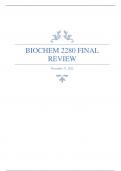Summary
Summary Comprehensive final exam review: EVERYTHING you need to know from student who got 97% in Biochem 2280
- Course
- Biochem 2280
- Institution
- University Of Western Ontario (UWO )
Comprehensive final exam review: EVERYTHING you need to know from student who got 97% in Biochem 2280. Includes notes from all prep 101 sessions.
[Show more]



